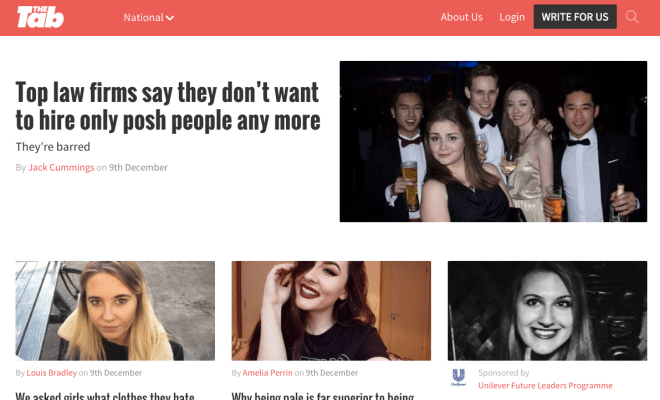The online disruption of journalism continues apace. Today The Tab, a hyperlocal news site aimed at young people and written mainly by “grassroots” (read: unpaid) student journalists, has raised $3 million from Balderton Capital to build out its business. This is The Tab’s first fundraise and the startup — originally founded in the UK — will be using it to expand in the U.S., out of an office in New York run by co-founder and editor-in-chief Jack Rivlin.
Up to now, The Tab has made its name in the UK, where the company has — mainly by word of mouth and social media channels like Snapchat that are already used by its target demographic — picked up some three million monthly unique visitors and over 90% penetration at 32 universities.
“I’d encourage anyone unsure [if The Tab is popular] to ask a student in the UK if they read The Tab,” Rivlin told me in an email interview. “Everyone does.” The company is now live in some 25 schools in the U.S., including all the Ivy League schools and several large universities. In November, the first full month of operations in the U.S., The Tab registered half a million uniques.
The idea up to now has been, not unlike something like Snapchat’s Stories or YikYak, to target content on a geographic basis, tying covering to university channels. There is also general content that (in theory) appeals to the general demographic.
Topics range from things like “Why I’m leaving Clapham, the most basic place in London” (subtitle: “It’s a hellmouth”) through to “I dropped out of Manchester and Cambridge but it’s honestly fine“. The home page of the website is heavy on pictures of young and bubbly women above the fold.
“[Co-founder] George and I wrote for the student paper at Cambridge University, and we realised none of our friends were reading the stories in the paper because it focused on things like middle eastern politics and Premiership football,” Rivlin said. “Big topics, but ones which student writers don’t do great justice to. We decided to build a site which covered the student bubble, where there are so many great stories which go uncovered.”
He says the response was “massive,” with 25,000 page views per day in its first week, underscoring the gap in the market that The Tab was filling.
But the fact that there are stories about what clothes girls hate boys to wear and pieces on 24 year-old pilots, doesn’t mean that The Tab is completely content-lite and devoid of touching on bigger stories. There are videos of campus anti-racism protests — which debut first on channels on platforms like Snapchat and are sometimes made only to live there.
“We differ from student papers because we focus on local stories which our readers really care about, and we encourage our reporters to leave their bedrooms and find new information. There is a serious lack of that kind of original, real reporting right now, even though it’s what everyone values the most.
A lot of people have lamented that journalism is dead, and that the Internet killed it, but in fact we’ve been seeing a resurgence of focus on content, with the new generation powered, sliced and diced in ways that were not possible before. The Tab is a part of that, but so are many others, including Snapchat itself, Mic.com, Twitter, Facebook and many others.
Currently, the vast majority of the content is being crowdsourced, and created by people who are not getting paid. It’s a volume game. Rivlin said 250 students are signing up to write for The Tab every day at the moment, and “We have an army of 3,000 talented grassroots reporters who produced 15,000 stories in 2015. In 2016 that number will be 37,000 stories,” he added.
There is, however, also a core group of editors who are at The Tab itself who are paid and work on pulling the rest of the content into shape.
This model is an interesting one: it means that The Tab has essentially cut down one of the costlier parts of building a publication — hiring talent. And it also means that it can stay fluid enough to encourage more people to write and bring in work that is more topical from those on the ground — the very essence of citizen journalism.
Still, there have been some failures in hyperlocal and citizen journalism, and it will be interesting to see how The Tab evolves its own business model, which today is based not on display but only native advertising, with brands like Unilever hopping on board to target the very coveted younger demographic reading the publication.
For now, the plan is to stick to its unpaid knitting until it gets bigger.
“Our way of rewarding our best contributors is to hire them when they graduate, which we’ve done with 29 of them. We’ve also helped more than 70 into jobs in the media at places like BuzzFeed, the Guardian and Vogue,” Rivlin said. “I’m confident that as we grow students will continue to get out more from The Tab than they put in. Tab reporters get amazing training events, and they get a chance to reach an enormous audience – the average story gets 5,000 page views. They are the most important people in The Tab and always will be.”
